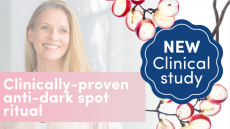Lutein skin health study elicits excited response at conference
lutein and zeaxanthin on skin health presented yesterday is
expected to open up a whole new market for suppliers of these
antioxidants in oral and topical beauty products.
Lutein, a nutrient found in various foods including green leafy vegetables and egg yolk, has a ten-year history in the dietary supplement market as a nutrient to reduce the risk of age related macular degeneration (ADM). With eye health as its main sput, the lutein market is currently estimated to be worth in the region of US$100m and $130m.
Although some earlier studies have shown that a daily lutein supplement may help bolster the skin's natural antioxidant system and protect against sun damage, this is the first time it has been assessed for more specific, age-related skin benefits: hydration, elasticity and superficial skin lipids.
The topline results were presented yesterday at the Beyond Beauty conference in Paris by lead researcher Professor Pierfrancesco Morganti, professor of applied cosmetic dermatology at the University of Naples, Italy. According to a spokesperson for Kemin, which supplied its FloraGLO lutein for the trial, the presentation was attended by top players in the cosmetics industry, and was followed by almost half an hour of questions.
The study involved female Italian subjects aged 25- to 50- years, who were divided into different test groups and administered 10mg of oral lutein and/or 50ppm of lutein in a topical formulation each day over a 12-week period.
Prof Morganti told NutraIngredients.com that the study has been accepted for publication in a major international peer-reviewed journal and is expected to appear in the coming months. Its title is Clinical evidence for lutein and zeaxanthin in skin health, part 1: comparison of placebo, oral, topical and combined oral/topical xanthophylls treatments. While discussion of the full results and methodology is pending publication, Prof Morganti told Beyond Beauty attendees that the oral lutein supplement was seen to increase skin hydration by 38 per cent, skin elasticity by 8 per cent, and the level of superficial lipids by 33 per cent (after adjustments for placebo).
Lutein was also seen to decrease oxidation of lipids - the process that causes degradation - by 55 per cent.
In the group that received both oral and topical interventions, hydration increased by 60 per cent, elasticity by 20 per cent, and superficial skin lipids by 50 per cent. Lipid oxidation was seen to decrease by 55 per cent.
The results have been welcomed by Kemin since they provide scientific support for taking FloraGLO into a new, potentially lucrative market. What is more, it is ageing consumers who are most likely to be aware of lutein for eye health as they are most at risk from ADM, meaning that marketers will already have the advantage of recognition when presenting it to the same demographic for skin health.
Zeaxanthin has a shorter history of use than lutein, but manufacturers of that nutrient are also likely to be pleased with the findings - not least because they already market it for use in combination with lutein for ADM risk reduction.
The global market for 'beauty from within' supplements has been increasing over the last few years, but as a relatively new field it is not yet tracked by the major market researchers. However the buzz about it in both the cosmetics and the supplements is evidenced by new ingredients and discussions at industry events.
In the US, this week sees the second trade show dedicated to skin care supplements, Inner Beauty, as part of Health and Beauty American in New York.












